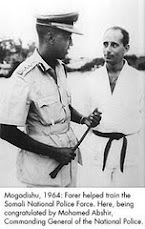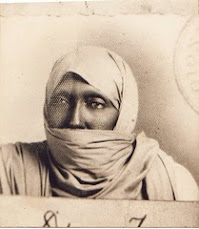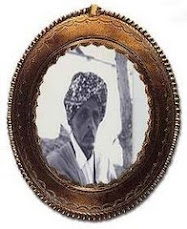 The photos were laid out one after another, headshots of five young Somali-Canadian men who disappeared in mid-October.The man from the East Africa desk of the Canadian Security Intelligence Service asked anguished parents the usual questions: Do you recognize any of the men in these pictures? Did you know them, or did your son? Did anything change in his life recently? Any indication of new friends or new interests?The families often had no answers. Yes, some sons had recently chastised their parents for not showing sufficient religious devotion, friends say. Others had dropped out of college or lost interest in their studies. But most parents remain bewildered by their sons' disappearance.The men left the country without a word of warning. They range in age from early 20s to early 30s and all worshipped at the Abu Huraira mosque in North York, community leaders say. Two or three have since called home to say they travelled to Kenya, but didn't say whether they ever plan to return to Toronto. The language they used in the phone calls is similar, an indication that they may have been told what to say. Security officials believe the missing men have crossed Kenya's northern border with Somalia to join al-Shabab – literally “the youth” – an al-Qaeda-inspired Islamist movement that has swept across southern and central Somalia.“Somalia's fragile coalition government appears helpless against a widespread Islamist insurgency that is gradually tightening its grip,” RCMP Commissioner William Elliott said in a speech last month. He added he was particularly concerned about the jihad spreading to “Somali-Canadians who travel to Somalia to fight and then return.”On Thursday, a suicide bombing believed to be the work of the al-Shabab ripped through a graduation ceremony in Mogadishu, killing three Somali cabinet ministers, several journalists and more than a dozen students. Similar bombings have been perpetrated by Somalis raised in Europe and the United States.In Somalia, and increasingly in Canada, community leaders view such attacks as war on their own futures. The refugee communities that fled the civil strife 20 years ago had hoped that generations raised in the West would break the cycle of bloodshed, poverty and anarchy. The cruel twist is that a handful of youth within the Somali diaspora are being pulled back to their homeland to perpetuate it.Security officials say al-Shabab is to Somalia what the Taliban was to Afghanistan a decade ago: Violent Islamist warriors who promise law and order, but whose barbaric practices include cutting off the limbs of thieves and stoning teenage rape victims to death.Somalia hasn't had a stable national government since 1991. The U.S., the UN, Ethiopia and the African Union have all tried unsuccessfully to bring a semblance of security to the country. The current leadership, known as the Transitional Federal Government, has limited reach even within the capital, Mogadishu. It's opposed by several rebel groups, most notably al-Shabab, as well as the pirates that hold sway in the northern province of Puntland.Last month, U.S. prosecutors charged a group of American Somalis with recruiting at least 20 of their own kinsmen from the Minneapolis area to join the al-Shabab, including some who have become suicide bombers. Until recently, no one in Canada thought Toronto would be the next target.“We used to argue with our American friends. We would say, ‘We will never have this extremism in Canada because we are a tolerant society.' … None of our mosques were known for spreading an extremist message,” said Abdurahman Jibril, head of the Somali Canadian National Council, a group that lobbies to improve social services for Somali immigrants.
The photos were laid out one after another, headshots of five young Somali-Canadian men who disappeared in mid-October.The man from the East Africa desk of the Canadian Security Intelligence Service asked anguished parents the usual questions: Do you recognize any of the men in these pictures? Did you know them, or did your son? Did anything change in his life recently? Any indication of new friends or new interests?The families often had no answers. Yes, some sons had recently chastised their parents for not showing sufficient religious devotion, friends say. Others had dropped out of college or lost interest in their studies. But most parents remain bewildered by their sons' disappearance.The men left the country without a word of warning. They range in age from early 20s to early 30s and all worshipped at the Abu Huraira mosque in North York, community leaders say. Two or three have since called home to say they travelled to Kenya, but didn't say whether they ever plan to return to Toronto. The language they used in the phone calls is similar, an indication that they may have been told what to say. Security officials believe the missing men have crossed Kenya's northern border with Somalia to join al-Shabab – literally “the youth” – an al-Qaeda-inspired Islamist movement that has swept across southern and central Somalia.“Somalia's fragile coalition government appears helpless against a widespread Islamist insurgency that is gradually tightening its grip,” RCMP Commissioner William Elliott said in a speech last month. He added he was particularly concerned about the jihad spreading to “Somali-Canadians who travel to Somalia to fight and then return.”On Thursday, a suicide bombing believed to be the work of the al-Shabab ripped through a graduation ceremony in Mogadishu, killing three Somali cabinet ministers, several journalists and more than a dozen students. Similar bombings have been perpetrated by Somalis raised in Europe and the United States.In Somalia, and increasingly in Canada, community leaders view such attacks as war on their own futures. The refugee communities that fled the civil strife 20 years ago had hoped that generations raised in the West would break the cycle of bloodshed, poverty and anarchy. The cruel twist is that a handful of youth within the Somali diaspora are being pulled back to their homeland to perpetuate it.Security officials say al-Shabab is to Somalia what the Taliban was to Afghanistan a decade ago: Violent Islamist warriors who promise law and order, but whose barbaric practices include cutting off the limbs of thieves and stoning teenage rape victims to death.Somalia hasn't had a stable national government since 1991. The U.S., the UN, Ethiopia and the African Union have all tried unsuccessfully to bring a semblance of security to the country. The current leadership, known as the Transitional Federal Government, has limited reach even within the capital, Mogadishu. It's opposed by several rebel groups, most notably al-Shabab, as well as the pirates that hold sway in the northern province of Puntland.Last month, U.S. prosecutors charged a group of American Somalis with recruiting at least 20 of their own kinsmen from the Minneapolis area to join the al-Shabab, including some who have become suicide bombers. Until recently, no one in Canada thought Toronto would be the next target.“We used to argue with our American friends. We would say, ‘We will never have this extremism in Canada because we are a tolerant society.' … None of our mosques were known for spreading an extremist message,” said Abdurahman Jibril, head of the Somali Canadian National Council, a group that lobbies to improve social services for Somali immigrants.What's most troubling for Somali-Canadian leaders is that these are not young men who struggled to adjust to life in the West. At least two were born in Canada. The others were educated here from primary school onwards. They are the children of respected families who have found work and integrated into the broader community, leaders say. They attended either college or university. Most of the missing men can't even speak Somali, the community leaders add.Parents are perplexed: They still see the Somali conflict as an internecine tribal war, not a religious conflict. How could their sons reconcile returning to a ravaged country their families sought so desperately escape?A further contradiction is that they may have joined a movement based primarily in Somalia's south, in the city of Kismayo, even though four of the five men are descended from families from the relatively stable northern province of Somaliland.
Somaliland was overseen by the British during the colonial era, while the south was run by the Italians. Somalis generalize by describing northerners as more reserved, and southerners as more outgoing. Northerners live primarily in the Scarborough area, while southerners dominate the area known as Little Mogadishu, around Kipling Avenue and Dixon Road. The bulk of Toronto's 50,000 Somalis live in the apartment towers and public-housing projects that dot that corner of Etobicoke.Omar Kireh, administrator of the Abu Huraira mosque, where the men prayed, said it's strange that northerners would join a southern insurgency. But nothing is predictable with the younger generation, he added, who know little of the country's fractious tribal politics.“It's upsetting. Their parents are worried,” said Mr. Kireh, a soft-spoken middle-aged Somali with a grey beard. “Think about someone missing a loved one for just one night. This is much worse.”His mosque, a nondescript, out-of-the-way building on a North York cul-de-sac, started above a convenience store not long ago, and has quickly grown by promising to focus on youth and back-to-basics Islam.In the fall, the mosque's new, hard-line imam, a charismatic young Somali named Said Rageah, created a minor controversy. In a lecture to the congregation, he said Muslims in Canada have to stop “so-called Muslims” who team up with “kuffar” (infidels) to stop the spread of Islamic dress. Imam Rageah urged true Muslims to stand fast for the right to cover up, saying he wanted to see beards, niqabs , and other Islamic dress “everywhere in the city.”Imam Rageah was not at the mosque last week, but Mr. Kireh, described the controversy as a tempest in a teapot. He said the sermon was taken out of context and the real concern is getting the missing men back home.To protect their families, he won't reveal the men's identities, and he said he's not sure what might have motivated them to leave the country. Perhaps it was for the sake of adventure, he suggests. But he stresses that no one yet knows where they are, or whether they have joined al-Shabab.Recruitment is a source of much speculation in the Somali community. Many say it was done through the Internet, perhaps in video-chat rooms that leave no record of what has been said.Others raise the possibility of a mysterious sixth man, an older gentleman who travelled frequently between Canada and Somalia and may have acted as a recruiter.“I'm told that the person who recruited them left the country before them and then made arrangements for them to follow him,” said Ahmed Hussen, president of the Canadian Somali Congress.How they were targeted is still a matter of debate. Many mothers say they worry their sons could be next.“Al-Shabab is going to take the bright ones: Usually it's clean cut, conscientious well-educated people. That's why you always hear these kids are from good families. These are middle-class kids. That's why it's so shocking. If they can infiltrate these kids then nobody is safe,” said one Somali community leader, who asked to remain anonymous because he's working to find the missing men.“Today, al-Shabab, al-Qaeda, they're an attraction for the young people. In our day it was socialism and injustice … now it's Islam, and the injustice they see is Americans bombarding the children of Palestine and Afghanistan,” he said.If the men have joined the insurgents, they have likely already been moved to a training camp in the bush outside Kismayo to be cleansed of their Western tendencies, he added. Eventually they will be pushed into the fight.If things have already gone that far, it will be difficult for the men to extricate themselves, should they have a change of heart.Mr. Hussen said two Minnesota men who tried to leave were executed by the insurgents.
The United States and Australia have formally blacklisted al-Shabab as a banned terrorist group. Canada has yet to follow suit.Part of its reluctance may have to do with complications arising from the kidnapping of Amanda Lindhout, who was held for 15 months in Somalia until her release a couple of weeks ago.A Somali gang shuffled the Canadian journalist through some al Shabab-controlled cities and threatened to hand her over to the terror group at times. Designating al-Shabab as a banned terror group could've been taken as a provocation that might have endangered her life. The CSIS agent who met with parents of the missing men reassured them that if the men return to Canada they may not be subject to sanction under Canadian law, because the group is not formally banned. The RCMP, though, say travel to support any terrorist group can be considered a crime. For the parents of the missing men, the question is whether they will come back at all.http://www.theglobeandmail.com/news/national/they-are-born-in-canada-educated-from-respected-families-and-they-might-be-fighting-for-the-shadowy-al-shabab/article1389876/



.jpg)












No comments:
Post a Comment